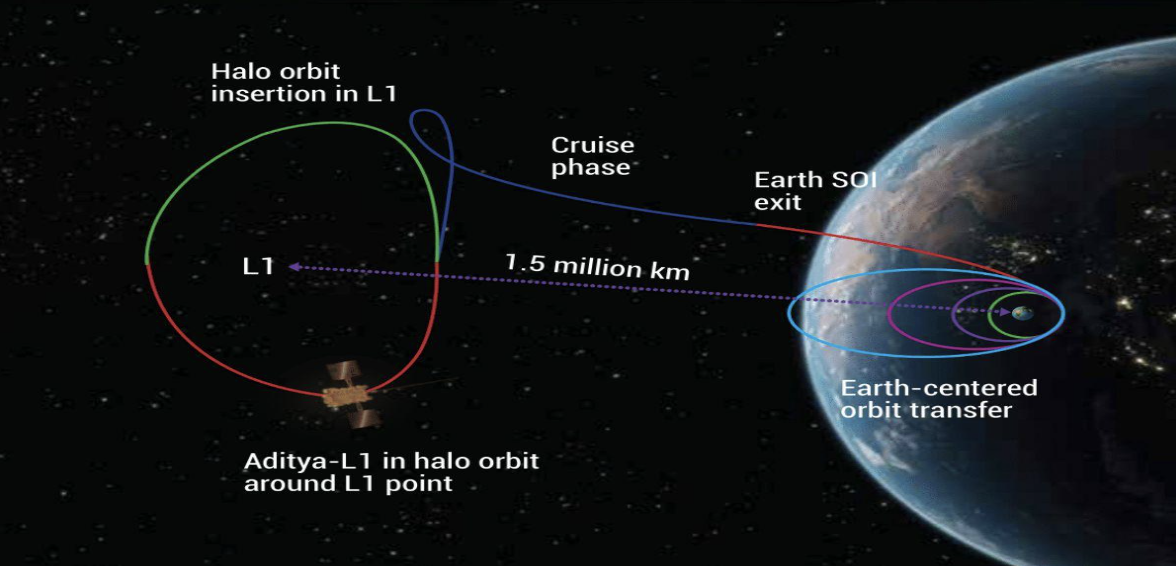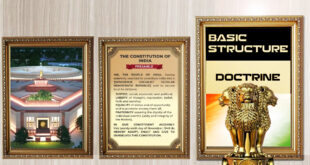Aditya L1
India’s first solar mission to study the Sun from L1 point between the Sun and the Earth.
- Launched on PSLV-C57 rocket from Srihari Kota spaceport
- Second astronomy observatory class mission
OBJECTIVES
- Observe photosphere, chromosphere and corona of sun in different wavebands
- Understand the physics and heating mechanism of the solar corona
WHY TO STUDY THE SUN
- Understand sun’s radiation, heat, flow of particles and magnetic field
- Understand the heat anomaly of solar corona
- Understand influence of solar events on weather
WHY LAGRANGIAN POINT 1
- Makes mission fuel efficient
- Unobstructed view even during eclipse

- Payloads can directly observe the sun
L1 is already home to Solar and Heliosphere Observatory Satellite.

PAYLOADS
Visible Emission Line Coronagraph (VELC)
- Primary payload
- Imaging of solar corona
- Capable of simultaneous imaging, spectroscopy and spectro-polarimetry
Other payloads
- Solar Ultraviolet Imager (SUIT): Photosphere and chromosphere imaging
- Solar Low Energy X-ray Spectrometer (SoLEXS): Electromagnetic wave spectrometer
- High Energy L1 Orbiting X-ray Spectrometer (HEL1OS): Electromagnetic wave spectrometer
- Aditya Solar wind Particle Experiment (ASPEX): Solar wind analyzer
- Plasma Analyzer Package for Aditya (PAPA): Solar wind analyzer
- Magnetometers: Study in situ magnetic fields
The Digital India Act 2023
The digital India Act, 2023 (DIA) is a proposal law in India that aims to regulates the digital landscape in the country. It is intended to replace the existing Information Technology Act 2000, which has been criticized for being outdated and inadequate.
What is the need of DIA 2023
- To address the inadequacies of Information Technology Act 2000
- These provisions underscore the legislative responsibility to the ever-changing digital landscape.
- To bring India’s regulatory landscape in sync with the digital revolution of the 21st century.
- DIA is a commendable step towards addressing the challenging of the digital age.
- Reenforces the rights of the people.
- It is a crucial step towards ensuring, accountable and innovative digital future for India.
- It promotes ethical AI practices, data piracy in blockchain applications, and mechanisms for accountability in the use of these technologies
Key Provisions
- It places a strong emphasis on online safety and trust, with a commitment to safeguarding citizen’s rights in the digital world
- New guidelines for the growing new-age technologies like AI and Blockchain
- The concept of an open internet, striking a balance between accessibility and necessary
- Right to be forgotten
- It Potentially shifts the online accountability standards by reviewing the safe harbour principles
Other NEWS
| Dhole | IUCN Endangered
a wild canid found in the forests of central, south, and southeast Asia Threats: human disturbances, habitat loss, prey base reduction, retaliatory killings |
| MENA Climate week | Middle East and North Africa Climate week’s second conference held at Riyadh
These regions are among most vulnerable to the effects of climate change |
| Gilt Fund | A type of debt mutual fund
gilt funds primarily invest in government securities They are safer and low risk investment option |
| Indian Air Force | Union Jack in the upper left canton
The RIAF roundel (Red, White & Blue) on the fly side The Air Force Crest in the top right corner The motto of the IAF is inscribed below Himalayan eagle in golden Devanagari. The IAF motto has been taken from verse 24, Chapter 11 of the Bhagavad Gita. |
 Chinmaya IAS Academy – Current Affairs Chinmaya IAS Academy – Current Affairs
Chinmaya IAS Academy – Current Affairs Chinmaya IAS Academy – Current Affairs



